Are you planning to develop a social media app, but are confused about designing it?
Design is an element that you cannot underestimate in the app. An app interface has the power to create or break the app’s goodwill if you are suffering from the same.
We’ve got your back. Here we will discuss the app design guide, starting from the need for app design to practices that should be implemented for successfully designing the app.
Why is Social Media App Design Important?
Social media app design is an essential feature that enables users to get what they demand.
It refers to the process of creating a user interface (UI) and user experience (UX) that effectively facilitates interactions between users and the app’s functionalities, optimizing performance and engagement.
App design is one of the most important processes for creating the visual look, layout, and interface that impact the mobile app development process.
Know more about the importance of social media app Design :
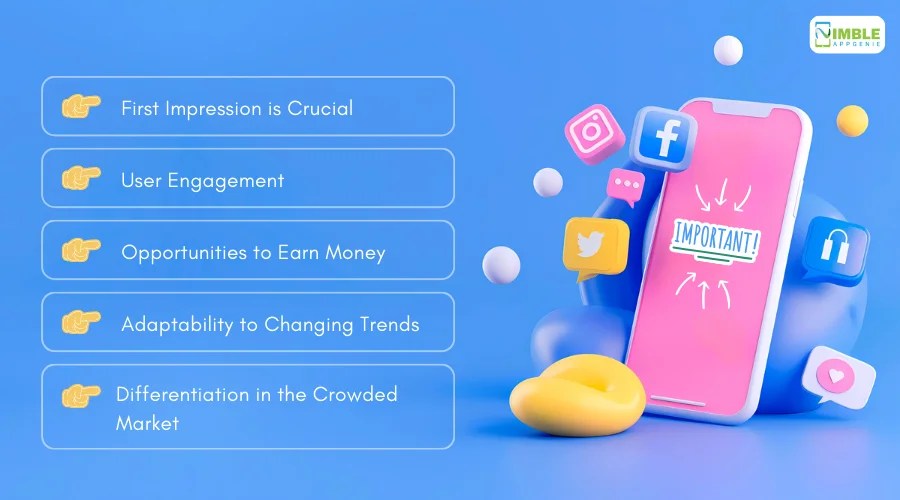
► First Impression is Crucial
- When someone opens the app, the interface is the first element that they experience. They see the vibrant colors and theme of the app and experience the navigation.
- Hence, app design plays an essential role in keeping app users engaged with the interface and leaving a positive impression.
- 137.8 billion apps and games were downloaded in 2024, a 1% decrease from the previous year
- The increasing volume of downloads indicates that app design plays an essential role here.
► User Engagement
- User Engagement plays a vital role in enhancing the success of the app.
- A pleasing UI design is integral for capturing users’ attention while keeping them engaged.
- Out of the world’s population, a total of 5.24 billion, which is 63.9% use social media apps.
- An increase in social media users indicates that users are engaged with the interface of the apps around the world.
► Opportunities to Earn Money
- Designing an app can enable opportunities to earn money.
- The total revenue of the social media networking market is projected to show an annual growth rate of 7.56%. This is resulting in a projected market volume of US$206.76 billion by 2029.
- In 2024, Meta Platforms earned total annual revenue of approximately 164.50 billion U.S. dollars.
- With the growing market of social media platforms, you can enhance your chances of earning revenue.
► Adaptability to Changing Trends
- Creating an app design can help you identify the current changing trends.
- Here you can check the usage of current technologies and their connection with the current apps.
- The emergence of new technology and evolving new content formats over social media are playing prominent roles in creating user engagement
- Thus, adaptation to such changes is important via changing the design of the app to survive in the competitive market.
► Differentiation in a Crowded Market
- Creating an innovative app design can help you make the app unique.
- It can enable the usage of effective social media practices that can grasp the attention of a wide population.
- Differentiation helps in distinguishing your social media app from other competitors.
- Providing users with an effective user interface is effective in improving the overall performance of the app.
Understanding the Basics of Social Media App Design
Learning the basics of social media app design can help you gain app ideas related to designing the app effectively.
Let’s check out the basics from the given list :
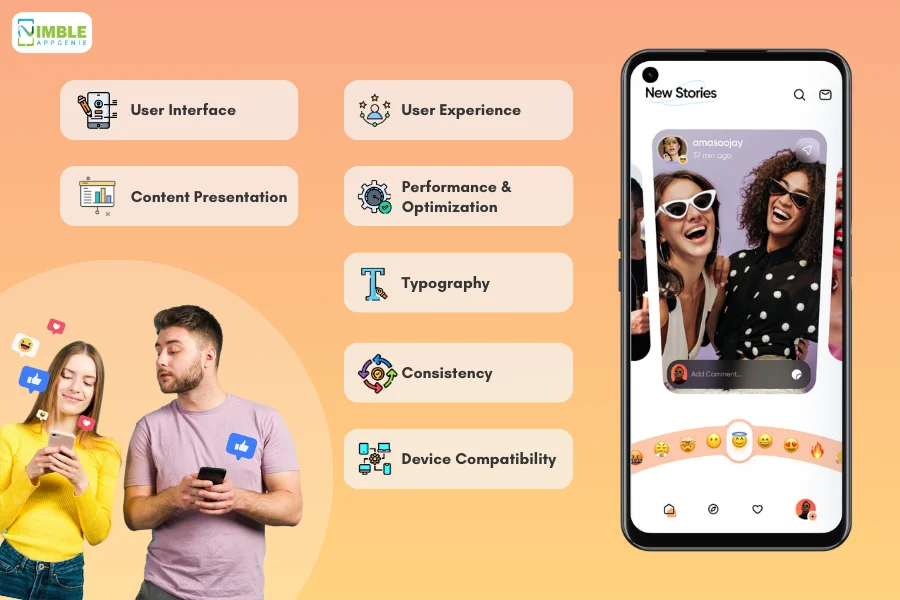
♦ User Interface
The User Interface of an application can be defined as the graphical layout, design elements, and navigational structures that facilitate user interaction with the app design. A well-designed UI makes the app more intuitive, visually appealing, and easy to navigate.
♦ User Experience
User experience includes the overall interaction and user satisfaction that they get through using the app. It is a feeling while using a product, application, system, or service. This refers to the overall interaction and satisfaction that users derive from using the application.
♦ Content Presentation
Content presentation is the order you present the content on the app. Here you should decide whether the content is supported by various devices or the media. Content presentation includes presenting videos, text, images, and links in a readable format.
♦ Performance and Optimization
App performance is one of the concerns nowadays; moreover, the design of the app can successfully contribute to the same. Here, you can optimize the app’s performance to ensure fast loading times and smooth interactions.
♦ Typography
Typography can be defined as a unique art where you arrange the content in order to make the written language legible, visually attractive, and readable. It comprises selecting and styling fonts after considering hierarchy to effectively convey written content.
♦ Consistency
While designing an app, you should be consistent with your practices. As a guide to creating mobile app wireframes, consistency refers to maintaining uniformity in elements, including visual style, layout, navigation, and interactions via the app.
♦ Device Compatibility
You should ensure the compatibility of the app design with the content that you are delivering. Here, device compatibility is an important ability of an application to function successfully across different platforms, including smartphones, tablets, and computers.
Popular Social Media App Designs for Inspiration
After learning the basics of app design, let’s move ahead to understand the popular social media app design. It will provide you with inspiration to move ahead with your app.
Here’s a list of popular social media app UI/UX designs :
► TikTok
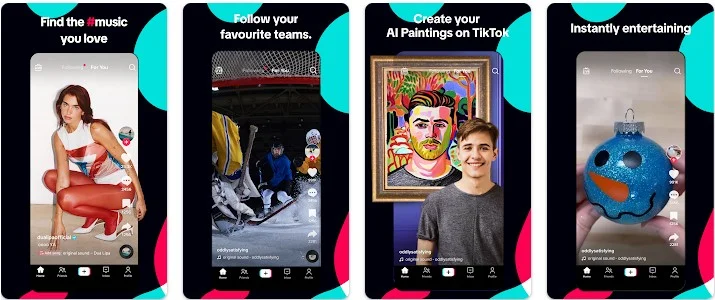
Here is the new kid on the block: TikTok has become one of the fastest-growing networks due to its effective social media app interface. The TikTok app currently has more than 1.7 billion users and is still counting.
You can create an app like TikTok that employs a simple UX design and focuses on short-term video content that features a vertically scrolling feed for seamless browsing.

When we talk about photo-sharing apps, Instagram has become one of the most popular social media platforms. With a constant font and a constant color theme, the app uses a simple layout.
The app is dominating the social media industry with features such as stories and reels. You can develop an app like Instagram by adding simple app design features.
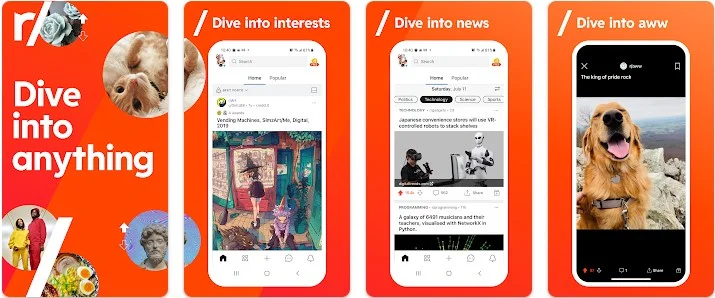
Reddit calls itself the front page of the internet. Here, they focus on displaying content that engages millions of people. The app displays the content in a simpler and clearer format. Its nature is to design a system for encouraging users to not only post information but also to vote on the content they value the most.
► YouTube

The major point of attracting viewers to the app is its visually appealing content that adds value to their lives. Its uniqueness lies in its vast diversity and accessibility.
Here, creators from across the globe produce a wide range of videos, from educational tutorials. You can build an app like YouTube to provide a platform for users who want to share their knowledge.

WhatsApp is a platform that caters to the minimalist needs of users by making it simple and easy for users to navigate and focus on their conversations.
The uniqueness of WhatsApp content lies in its private and direct nature. You can create an app like WhatsApp with multimedia capabilities that allow users to share different types of content.
► Snapchat
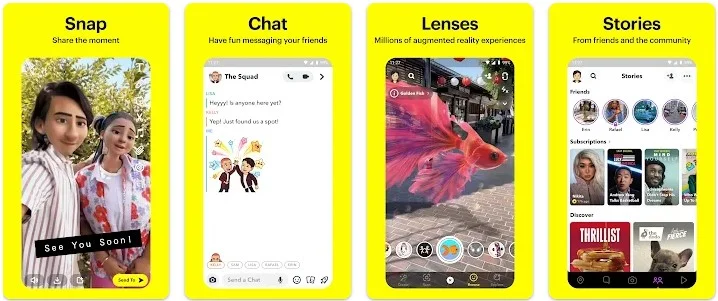
Snapchat social media app UI design focuses on crafting features that prioritize user engagement, innovation, and inclusivity.
Develop an app like Snapchat that provides users with a platform to share photos and videos that usually disappear after a set period. The design of social media apps emphasizes temporary, visually dynamic content that makes them unique.

The uniqueness of this social media app design platform is its versatile structure. With a variety of features and functionalities in a single platform, Facebook offers a diverse array of tools for communication, networking, and content sharing. It helps its users to curate their news feeds based on their interests and connections.
Process to Design a Social Media App
Till now, you have studied the importance of implementing app design along with the current market stats. You also learned about how popular apps implement app design, along with the basics related to designing a social media platform. Now it’s time to know the process and steps to implement social media app design.
Here you will find the answer to the process of designing a Social Media App :
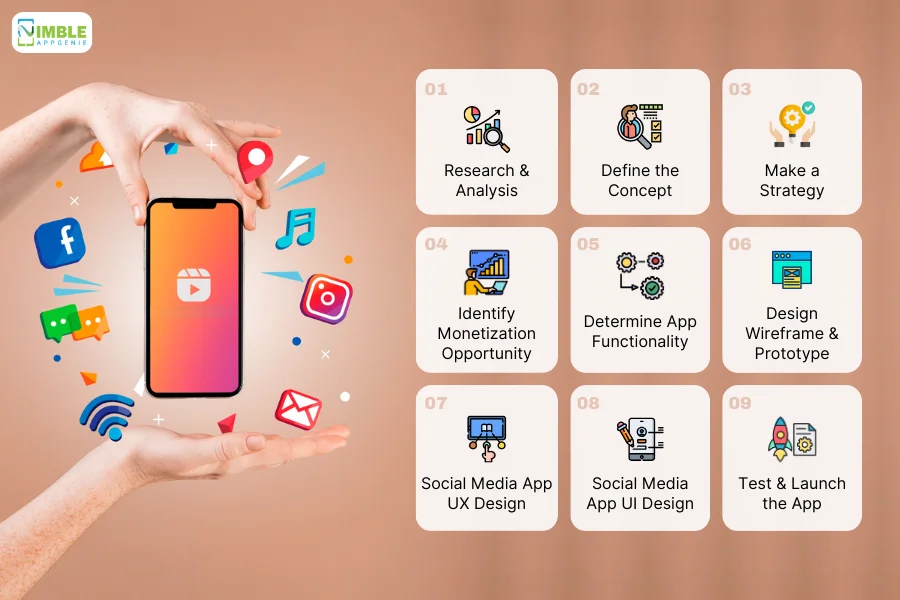
1. Research and Analysis
This is the first step towards social media app design. You should conduct market research that can provide you with a guide to the target audience and their end users. This will help you to create a platform that will address the needs of current app users.
Here, you can identify the gap in the market related to social media platforms and their usability. You can perform primary and secondary data analysis to successfully evaluate the market needs.
With the assistance of market research, you can define the ultimate goal of creating the mobile app. This research will assist you in calculating the future risks related to designing your future social media app.
2. Define the Concept
Now, you should define the type of concept on which the user interface of the social media app will rely. Here you have to define the app’s objectives, features, and functionality. You can create user personas along with user stories to guide app design decisions.
Here, you can define the type of content that you want to display on the social media app. It will help you make the content strategy on how your app users will see the content.
This can assist in identifying the type of audience you are going to serve in the future. This will help finalize the theme and color of your app’s user interface.
3. Make a strategy
Here, you should make a strategy that will align with developing the social media app. Develop a strategy and define your app design idea. In this step, you can analyze the app competitor’s social networking platform app design.
It will be effective in clarifying the purpose and will provide an informative direction for the app. You can make a user-centric approach for your app by understanding the requirements of the target audiences.
This can even help in resource allocation and in performing consistency as well as cohesion. Here, you can also evaluate the measurable outcomes after designing the strategy for your mobile app.
4. Identify Monetization Opportunities
This step may seem like something you should think about later. However, deciding the pattern of earning money while designing the app is a crucial process that you should consider. Here you can implement social media app monetization strategies to improve your market presence.
After identifying the monetization models, you can align your app values with those of the business. Here, you can balance the user’s value with the revenue generation. It can help you to evaluate the long-term sustainability of the mobile app.
This can add up to a business and can help you identify the approximate value that you can earn from the app with an evaluation of the future monthly monetization criteria.
5. Determine the Functionality of the App
You can prioritize the features based on their importance to users and feasibility within your resources. With a definite guide to creating a design for a social media app, you can transform your app functionality as per its requirements.
A good functionality of an app can increase user satisfaction. It can help you identify patterns of user behavior that can even lead to positive word-of-mouth marketing.
This can help in providing technical feasibility and can provide a platform to assist you in identifying app performance optimization patterns.
6. Design Wireframe and Prototype
Here, you need to develop a mobile app wireframe. This will assist you in creating a blueprint and layout for each screen in the app. You should develop user flows to map out the app’s navigation and interaction paths.
You can focus on developing a seamless and intuitive user experience that can help users through key actions and encourage them to engage with the app. Here, developers can start by focusing on developing mobile app prototypes.
A prototype is all about creating a tangible working model that displays how the app will appear in the future. This helps to identify the app’s functionality for both Android and iOS platforms.
7. Social Media App UX Design
Under this step, you can evaluate the user experience of your target users by framing the UX design. You can rely on the interaction scenario with the user. Here, a well-designed user experience can encourage engagement with the app, resulting in increased usage and retention of users.
An attractive user design thrives on making connections and interactions among users. UI/UX of social media apps will comprise delivering personalized experiences, which are key to keeping users engaged and satisfied.
Designing a social networking app that is effective in providing accessibility to the users for diversified features such as screen reader compatibility, adjustable font sizes, and alternative text for images.
Also Read: UX Design Principles
8. Social Media App UI Design
App UI design focuses on how the app looks and functions. It comprises defining the layout of the app. Here, you decide to design UI elements that include text fields, checkboxes, icons, and buttons.
The UI design of a social media app determines its visual appeal and aesthetics, which play a significant role in retaining and attracting users.
Clear and intuitive navigation elements such as buttons, icons, menus, and a guide improve the overall appearance of the app.
9. Test and Launch the App
Now, in this step, you need to test the design of the app and its sync with the overall functions. Here you can test the app across different platforms. It is essential to identify usability issues and validate design decisions to enhance the user experience.
Testing the app can assist in optimizing conversion rates and ensuring compatibility and performance. Under this step, you can recognize compatibility issues to ensure that the app functions as intended for all users.
Here in this step, you will test all features and analyze the impact of the app design on actual users. It can help you to evaluate the future retention rate of users of the app.
These are the overall steps that you should follow when you decide to build the design of the app. Do you want certain steps that can increase the performance of your app by enhancing its design? Check out the next section.
Quick Tips to Design a Social Media App
Now, as you are clear with the idea of how to design a social media app. But what if we told you that there are some effective ways to design a social media app and improve its performance?
Here are some quick tips for the social media app design guide :
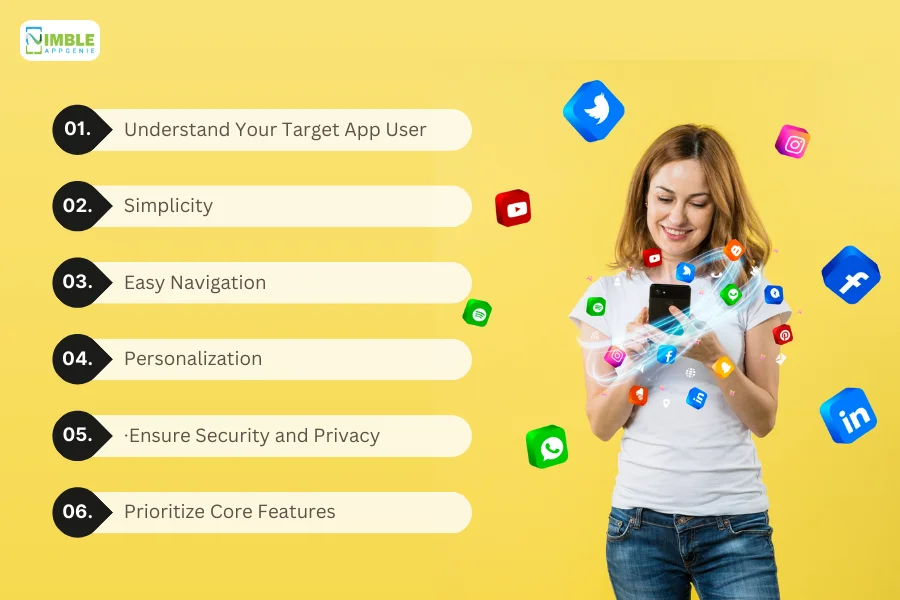
➤ Understand Your Target App User
This is a quick tip where you should identify your target end app user. Recognizing the target app user can assist you along the path of designing the app as per user demand. You should identify the user’s behaviors, demographics, and preferences.
➤ Simplicity
Simplicity is one of the best policies when it comes to designing a social networking app. Users always prefer to use an app that is simple and to the point. This will add value to your brand and can make it easier for users to navigate the application.
➤ Easy Navigation
The design of a social media app should be effective so that users can navigate through the app easily. You should try to keep the design of the app minimal and simple, as users might quit the application when they find it complex.
➤ Personalization
You should design the app in a customized way. Here, you should be free to interact with your social media application. Personalization can help to build a direct relationship with the end app users. Thus, you need to create a design that creates engagement by attracting potential users.
➤ Ensure Security and Privacy
Under this practice, you should ensure the security of the app by prioritizing users’ data privacy and implementing the latest robust security measures. You should keep transparent privacy policies that provide a seamless user experience.
➤ Prioritize Core Features
You need to identify and prioritize the best social media app features that provide unique value to users and differentiate your app from competitors. This is one of the best practices for social media app design in order to understand the end users’ demands successfully.
Collaborate With Nimble AppGenie For Social Media App Design
Designing a social media platform is not possible without an experienced and trusted team. What are you waiting for?
Partner with Nimble AppGenie, and we will help you in deciding the right app design for your social media app. We are the best social media app development company, experienced in designing apps based on current market trends.
We have already done it before; check out our recent developments. MM Arcade is among the social media apps that we created after evaluating the recent updates in the market on app design and other useful elements.
Conclusion
Designing a social media app requires a thorough understanding of user needs, market trends, and design principles. From creating engaging user interfaces to ensuring seamless navigation and prioritizing core features, every aspect of app design contributes to its success.
By following a systematic design process, including research, concept definition, strategy development, and testing, developers can create social media apps that not only meet user expectations but also stand out in a competitive market.
Additionally, embracing simplicity, personalization, and security while prioritizing user engagement can further enhance the app’s performance and user satisfaction.
FAQs
Social media app design is crucial because it creates the first impression on users, enhances user engagement, provides opportunities for revenue generation, adapts to changing trends, and helps differentiate your app in a crowded market.
A well-designed user interface and user experience captivate users, keeping them engaged with the app. This engagement is crucial for the app’s success, as it leads to increased usage and retention rates.
App design can enable various monetization opportunities by aligning with business objectives and balancing user value with revenue generation. Designing features that add value to users’ experiences can lead to sustainable revenue growth.
Adapting app design to changing trends ensures relevance and competitiveness in the market. By incorporating new technologies and content formats, app designers can keep users engaged and attract a wider audience.
Innovative app design helps make the app stand out from competitors by implementing effective social media practices and providing a unique user experience. This differentiation attracts users and improves overall app performance.
The social media app design process involves research and analysis, defining the app concept, developing a strategy, identifying monetization opportunities, determining app functionality, designing wireframes and prototypes, and testing and launching the app.
Designers can enhance app performance by understanding target users, prioritizing simplicity and easy navigation, implementing personalization, ensuring security and privacy, and prioritizing core features that add unique value to users.

Niketan Sharma, CTO, Nimble AppGenie, is a tech enthusiast with more than a decade of experience in delivering high-value solutions that allow a brand to penetrate the market easily. With a strong hold on mobile app development, he is actively working to help businesses identify the potential of digital transformation by sharing insightful statistics, guides & blogs.
Table of Contents

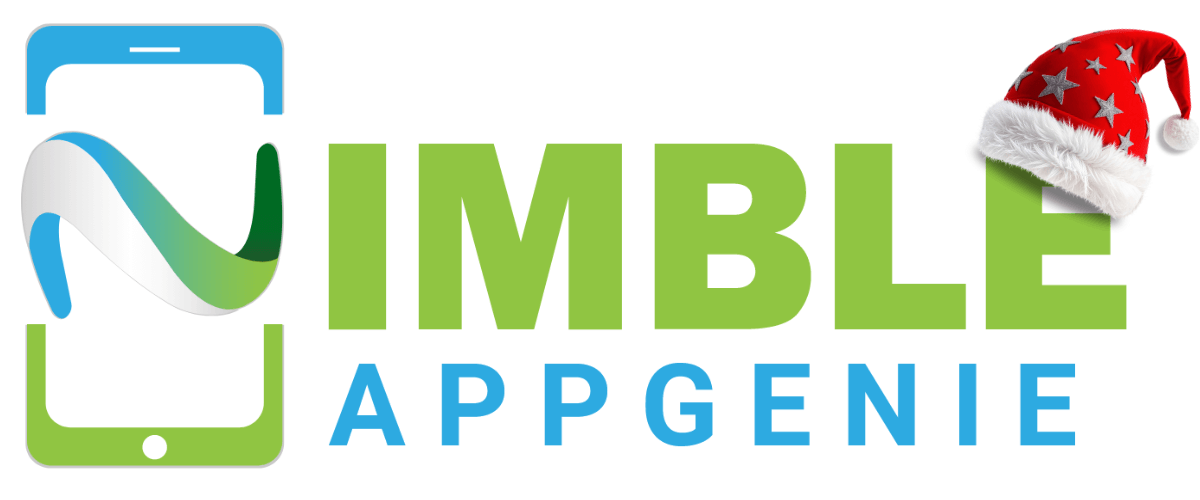





No Comments
Comments are closed.